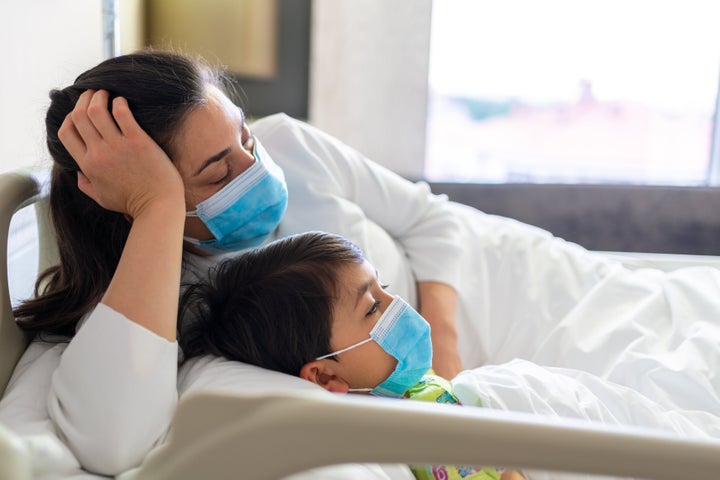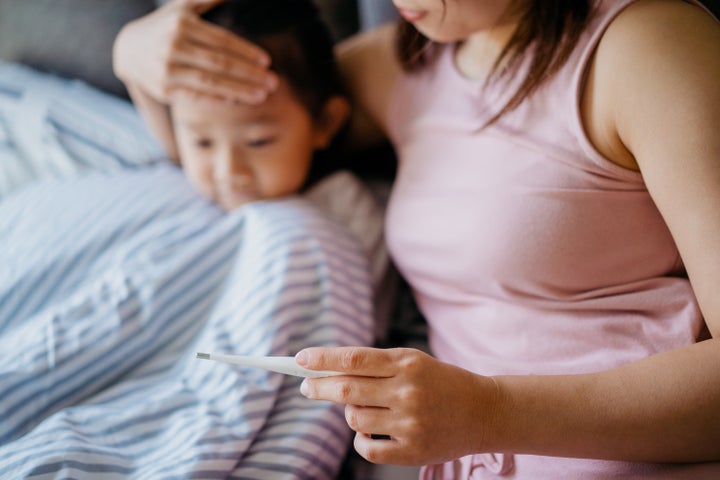
A record number of children have been hospitalized with COVID-19 amid the ongoing omicron surge. An average of 909 children were admitted to hospitals daily over the past week. And overall pediatric cases continue to climb.
Those numbers are a disheartening setback in a pandemic that has pushed parents to their breaking point for two years now, and the situation is likely to worsen as omicron continues its rapid spread throughout the U.S.
But there’s also good news for parents to hold onto, and important context for everyone to be aware of when it comes to the flurry of unsettling headlines. Here is what parents need to know about the current surge and hospitalizations, and what to do if your own child tests positive.
It’s serious if a child is hospitalized. But respiratory viruses are nothing new.
The Centers for Disease Control and Prevention tracks new hospital admissions of children with confirmed COVID-19 cases — not necessarily admissions directly because of it. So some children included in its recent counts have been hospitalized for something else, but find out they’re positive due to routine testing.
Others, however, are being hospitalized specifically to manage complications from COVID-19. That means they’re receiving treatments that are only available in the hospital, explained Dr. Danielle Zerr, an infectious disease specialist with Seattle Children’s in Washington, or that they’re in need of close monitoring.
“What we’re seeing in our own hospital is that the hospitalization for children with acute COVID-19 is the highest it’s ever been, but the vast majority of these are patients being admitted to the acute care units. We have very few needing critical care at this time compared to previous waves,” Zerr said.
Many children require oxygen and close monitoring, she explained. Others might need fluids because they’ve become dehydrated while sick. Those are the types of treatments that children often get if they’re hospitalized for other respiratory viruses, like RSV or severe croup.
So yes, it’s serious. But parents can take comfort in knowing that doctors have ample experience treating children for acute respiratory illness, and the overall pediatric mortality rates from COVID-19 remain extremely low.
Children under 5 and those with underlying conditions are at the highest risk of hospitalization.
The current rate of pediatric hospitalization is more than 4 in 100,000 for children under age 5 and about 1 in 100,000 for those age 5 to 17, The Associated Press reports.
Anecdotally, health care providers say that split is reflected in their own hospitals.
“I’m seeing more kids under 5 who are presenting with symptoms and need to be admitted than I’ve seen in previous waves here in New York,” said Margaret Aldrich, director of pediatric infection control at Children’s Hospital at Montefiore in New York City.
It’s too soon to say why that is, but Aldrich strongly suspects it is because they’re too young to be eligible for vaccination. (Pfizer has extended its clinical trials in younger children to test the efficacy of a third dose, but kids under 5 might not be eligible to get a shot until March or April.)
“I can’t tell you with 100% certainty that that’s the case, but as I look at what’s progressing here, that is a major concern of mine,” Aldrich said. Recent New York state data seems to back her up. More than half of New York’s recent pediatric hospitalizations are in children 4 and under, who are too young for vaccines. In addition, the majority of children over 5 who have been admitted to the hospital in recent weeks are unvaccinated.
It’s also possible that younger children are at additional risk for more serious complications simply because their physiology is different. That’s true of other respiratory viruses, like RSV, which tend to be riskier for younger children. But experts like Aldrich say it’s too soon at this point to have a complete picture of what is happening.
It is also important to keep in mind that nationally, most children being hospitalized have an underlying condition of some sort.
“About 55% of hospitalized children had an underlying condition, according to the CDC. These included obesity, asthma, neurologic disease, cardiovascular disease, autoimmune and immunosuppressive conditions, chronic lung disease, metabolic disease, gastrointestinal disease and hypertension,” said Carla Garcia Carreño, chief of infectious disease at Children’s Medical Center Plano.

If your child tests positive, reach out to their pediatrician.
If your child tests positive, take a deep breath. Remind yourself that in general, omicron is milder than past variants. It is likely that more children are being hospitalized right now simply because more children are getting infected in the first place.
“The omicron variant is about three times more contagious than the delta variant,” said Carreño. “Given this, we are seeing a very important surge in the number of cases. When cases in the community increase, pediatric cases will in turn increase as well.”
Once you’ve taken a moment to collect your thoughts, contact your child’s health care provider, the CDC says. They’ll be able to talk you through next steps and discuss any underlying risk factors your child might have. Also, try to separate your child from other family members to the extent possible.
For otherwise healthy children who are likely to make a full recovery, it’s still worth doing what you can to help your child’s body fight off the illness: Make sure they get plenty of rest and that they’re well hydrated. You might want to offer over-the-counter medications to help your child cope with fever or pain — but again, these are all things your child’s doctor can walk you through.
Although they are very rare, also know the red flags to look out for.
“If your child develops trouble breathing, chest pain, confusion or lethargy, discolored skin (pale, gray or blue), any signs of dehydration (dry mouth, no tears, decreased urination), or inability to take liquids by mouth, get emergency medical help immediately,” Carreño said.
Vaccination is the best protection against severe illness.
If your child is in an eligible age group, get them vaccinated and boosted, the experts interviewed for this piece all urged. Only 27% of children in this country between the ages of 5 to 11 have received at least one dose of the COVID-19 vaccine, while 64% of 12- to 17-year-olds have. Adolescents also recently became eligible for a booster dose if it has been five months since their last shot.
For all children — including those who are too young to be eligible for vaccines — remember the basic preventive measures that have helped stop the spread of the virus since the beginning. Mask up in public settings (now is a good time to consider getting your child a higher filtration mask rather than just a cloth one, Zerr said). Maintain social distancing as much as you can, and make sure your child frequently washes their hands.
Experts are still learning about COVID-19. The information in this story is what was known or available as of publication, but guidance can change as scientists discover more about the virus. Please check the Centers for Disease Control and Prevention for the most updated recommendations.